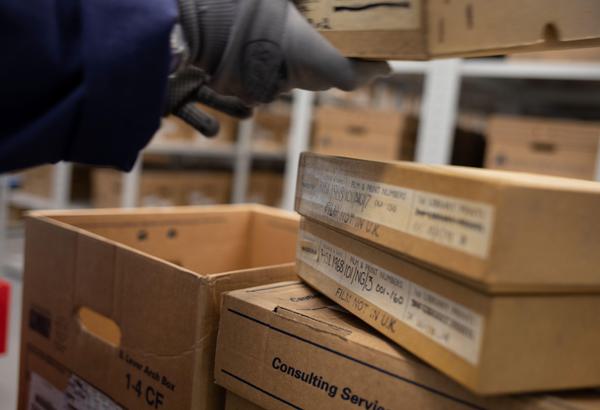
Caring for the Collection is crucial for digitisation and preservation
A member of our team cleaning a historic print before digitisation
Caring for the Collection is crucial for digitisation and preservation
Collections Care
The National Collection of Aerial Photography (NCAP) holds 30 million images in a variety of formats including print, film and digital. This vast collection requires specialist care and preservation, with physical prints and films stored in thousands of print boxes and film canisters. Much of this photography was made and used during wartime conditions, where long-term preservation was not the main concern.
History and Production
Before moving to its current home in 2008, the collections were under the care of various organisations, each having different storage and handling methods. This has led to a legacy of conservation challenges, which NCAP is now addressing.

Photographic prints and films are often unstable and can degrade over time, even when stored in good environmental conditions. NCAP faces additional challenges due to the circumstances surrounding the production of some materials.
For instance, much of the imagery in the Collection dates to the Second World War. These materials were often rapidly processed for intelligence purposes, leading to poor washing or fixing that left chemicals still in the prints.
Almost all pre-1970s film was produced on cellulose acetate or nitrate plastic. Over the years, the dangerous nitrate material has been removed and reformatted, however, the acetate plastic is the most common material in the archive. This is prone to rapid decay that can leave the imagery unusable today.
Issues and Concerns
The most common issues found by the Collections Care team are curled prints, mould, peeling emulsion, tears, sticky tape or glue, broken boxes, bent canisters, and decaying plastic film. NCAP's goal is to stabilise prints and film so they can be digitised in the safest way without causing any further damage to the image.
To obtain the best quality scan, all imagery must be examined and preserved before being handed over to the Digital Imaging team. All visible mould and dirt is carefully cleaned off in fume cabinets. Broken boxes or canisters are replaced so the collections will be stable when put back into storage.

Curled or creased prints will not lay flat on glass scanners, so they are humidified and flattened beforehand. Modern humidification chambers relax the prints, and traditional bookbinding presses flatten and dry the print over several days.
Imagery on rolled film often has dust or dirt which must be removed before scanning. This is done using film-cleaning machines which use soft rollers, anti-static fields and jets of air to gently remove dust with minimal contact. Any tears are repaired in line with current conservation guidelines, while historical tape repairs are removed.


Long-term Preservation Issues
Caring for photographic collections, especially ageing photographic film, presents significant long-term challenges. While many archives opt for cool or cold storage solutions to extend the material's lifespan, this has a substantial environmental impact when required for larger volumes of material. NCAP faces unique challenges given the extensive volume of photography, legal access requirements, and ongoing digitisation needs. Balancing the retrieval of valuable photographic information with the preservation of decaying physical collections is a significant concern for NCAP.
Pioneering digitisation efforts should see the collection transferred to secure digital formats within the next several decades. Despite this, a long-term storage solution is crucial to allow enough time for the preservation, digitisation and cataloguing of the collection; before materials degrade beyond use.

Caring for the collection underpins all NCAP activities. The integrated approach of preservation activities within digitisation processes ensures the best digital outputs but also prolongs the life of the archive.
NCAP is responsible for preserving both the information within photographic images, and the physical material. By effectively balancing these two aspects of the archive, NCAP ensures the accessibility of this unique photographic record for present and future generations.
IN THIS SECTION

Digital Imaging
Using the latest scanning technology, skilled technicians and robotic systems NCAP operates a highly productive digitisation facility.

Cataloguing and Access
All collections held by NCAP are open public record, once catalogued they are made available to the public.

Data Management
At peak efficiency, NCAP can create nearly 2TB of data a day which needs to be managed, transferred and secured for long-term preservation.